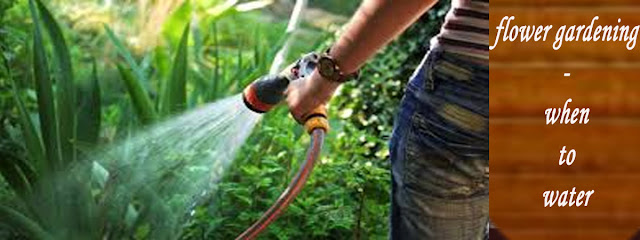Flower Gardening -When to Water
How to water plants?
It's all about paying attention ,giving love and care
By reading, working on the plants we will be able to know how to water a plant properly, which ensures the health and vitality of the plants. But we should find the best suitable time periods to water each plant according to its necessity.
When it comes to watering, there are no tough or speedy rules. It's an opinion that is dependent upon the kind of plant, the soil, the weather, the time of yr and numerous other variables. Fortunately, it is easy to resolve what to do — even for a teen on a scorching summer day.
you just wish to take a look at the soil. Before watering you should check the soil by inserting your forefinger into the soil. Over time, you get to know how heavy a pot must feel if the soil throughout the pot is thoroughly moistened. If it's not heavy sufficient, you water slowly till the entire soil in the pot is wet and water runs out the bottom. Then you lift the pot all over again to check that it feels proper.
It's an opinion that depends on the kind of plant, the soil, the weather, the time of 12 months and plenty of different variables. Fortunately, it is simple to determine what to do — even for a young person on a scorching summer season day.
After watering rigorously, a hanging pots/baskets elevate it to get a way for the way heavy it will have to feel. When it feels gentle and if the soil seems to dry, it's time to water.
The Best Way to sprinkle Water
The main important part is that all the water should runs down the root ball to get wet. Otherwise Watering is of no value if the water runs down the outside of the roots, leaving the roots on the core of the plant dry. This can happen when you water too quickly or pouring too much water without delay. Sprinkling is more effective where the hose connected with a small adjustable water sprinkler. The key's to be sure that water gets deep into the roots — whether you're sprinkling the seedlings, watering houseplants, watering a row of tomatoes or soaking thirsty shrubs and bushes.
You cannot lift your garden or lawn for the test whether it’s time to water, but you'll be able to use a soil moisture sensor. For a thorough investigation, push a spade into the soil near your plant and pull it again to peer how the soil seems. If it feels wet to an intensity of 6 to 12 inches, you might be in just right shape. If it is rough and dry, water!!! water!!! water!!!
Tips for Watering Your Plant Garden
1. Rootz. Remember that it is the roots that need get entry to to water, now not the leaves. Wetting the foliage is a waste of water and will promote the unfold of disease.
2. Water only when needed. Automatic watering timers are particularly helpful; just remember to watch the elements, and scale back frequency when rainfall is considerable. Too a lot moisture can be simply as damaging to vegetation as too little.
3. Water regularly. Lawns and annuals concentrate their roots in the most sensible 6" of soil; for perennials, shrubs and bushes, it is the top 12". In heavy soil, it'll take hours for water to percolate down 6-12". Use your finger or a shovel to test the development.
4. Water in the morning. If you do get moisture on the leaves, this gives them time to dry out. It's a lot trickier for plant illnesses to get a foothold when the foliage is dry.
5. Mulch the entire garden. Mulch reduces surface runoff and slows evaporation from the soil.
6. Use the precise tool. For environment friendly watering at the rootz, use a soaker hose or connect to an actual drip irrigation device as an alternative of a sprinkler.
PLANT WATERING TIPS
Many people are rightfully desirous about indoor plants upkeep. That's normally a reason why for not bringing any leafy plant inside the home; at most we allow cacti or two, but that's most often it. However, with the precise equipment and methods, it has now changed into more straightforward than ever to keep space plants alive and wholesome while you're away, either for business or on.
Welcome to the sharp gardening technology!!!
Prerequisite 1: Be confident that the plant's pot has drainage holes at the base to avoid damp that may create root rot.
Prerequisite 2: These methods are for crops that in reality wish to be watered weekly. Cacti and Succulents can live for a month without water so no need to compel to use the techniques under on them in case you are away for a couple weeks simplest.
WARNINGS OF OVER WATERING::
**New and Old leaves fall at the same time
**Flowers become Moldy




what is mulch?
ReplyDeletei have certain pots which has big holes at the bottom.. when i pour water in it, it just flows through the holes. what can be done on such kind of pots. the stem or roots are not getting enough water in those pots. i have put a plastic sheet at the bottom of those pots. is that ok?